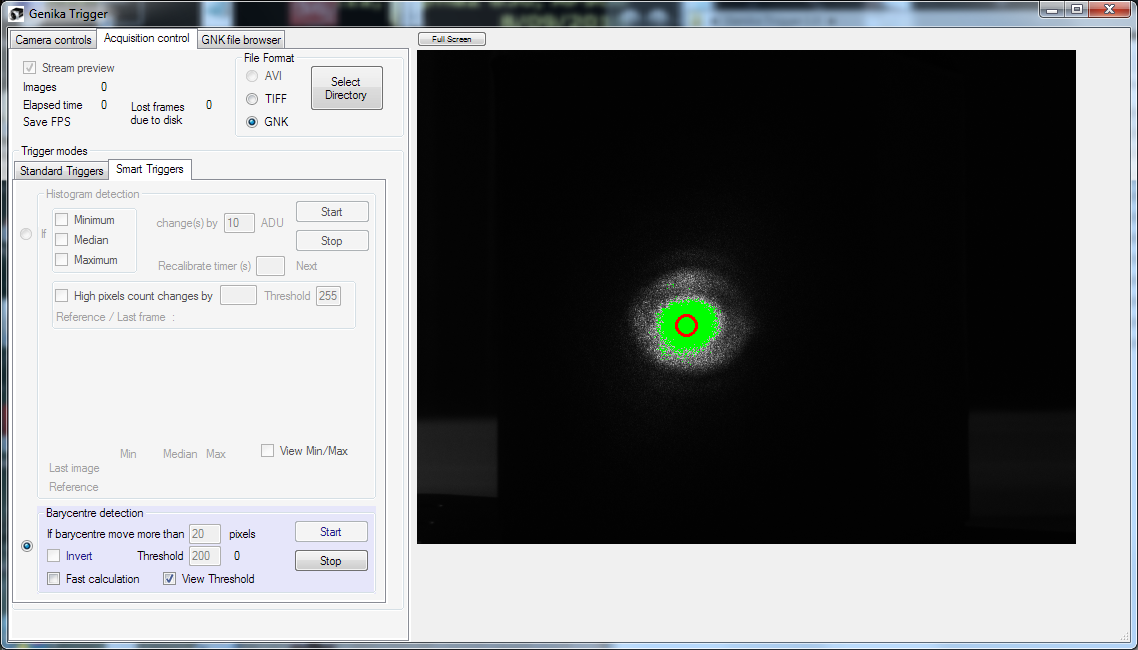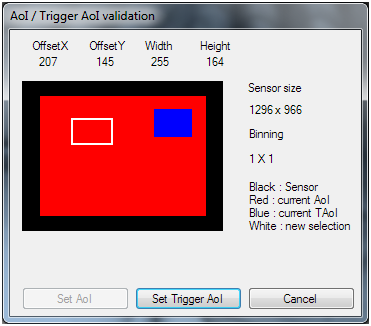Genika Trigger is an image acquisition software for science and biology applications. It provides Andor, Basler, IDS and AVT black and white cameras control through IEEE1394, GigEthernet, CamLink and USB interfaces along with smart trigger functions and a robust file format.
Smart triggering allows long time run without the need to save all the frames. It spares storage capacity and makes the datas processing much faster. Genika Trigger has minimal latency so you won’t miss the event your were waiting for !


1 : not tested
Genika trigger does not require any frame grabber to deliver acquisition speed over 100 frames per second (except for Andor Neo and Zyla cameras). Along with a Basler, IDS or AVT camera, it is a low cost solution for all kind of applications in science, research or medecine fields. Its smart triggering capabilities along with multi instance/multi camera master/slave capabilities allow you to acquire only pertinent images for your application:

– Passing by detection through min/max image threshold (Beings, planes, meteors…)
– Movement detection through image center of gravity calculation with programmable threshold (object surveillance)
– Particles or stars detection and count
– Flash detection through max image threshold or programmable high pixel count (Laser flashes, impacts, plane signaling, satellites, all sky detection…)
– Median level change
– Hardware triggering for multi-camera control (stereoscopic imaging)
– Sequencer
– Time lapse for slow evolution process (life sciences)

Application example : laser TEM shift monitoring
Genika Trigger is optimized to achieve the best reliability possible. Its proprietary GNK file format is crash proof (cannot get corrupted). The application also counts precisely lost frames and can run for days. It can start unattended by loading an existing trigger and camera configuration and opening the first camera available.

Hardware configuration : Core2Duo 2Ghz, Basler or AVT camera and Windows XP/Vista/Seven 32/64bits. If used at high FPS with smart triggering : Core i5 or i7, 4GB RAM and a fast disk subsystem.

AoI and smart triggers AoI setup window
Camera control
– Andor SDK3, Basler, IDS and AVT Firewire, CamLink (Andor), USB and Gigabit Ethernet B&W camera
– Multiple instances to control multiple cameras on one/several PC
– Cross instances master/slave mode through hardware triggers
– Multiple camera synchronization with an external function generator
– Low jitter/precise time stamping support. Multicamera image latency <500µs
– Bandwidth indication
– Camera change on the fly
– Load/save camera configuration
– Unattended camera opening on start
Image control
– Exposure, gain, gamma and black level
– Independent X/Y binning up to x3
– Force FPS mode
– Mouse support for AoI setup
– 8, 12 and 16 bits support
– IDS Log mode support for E2V sensors (since uEye 4.01), support of CMOSIS features (4.2.1)
Image tools
– Focusing assistant based on local micro-contrast and noise estimator
– Dark frame subtraction for exposure > 1s
– Image preview with zoom from 25 to 200%, false colors mode
– Histogram with Min/Med/Max and log² mode
– Line scan level on a user selectable line (right mouse click on image)
– Overlay reticle with pixel or real scale in mm
Standard triggers
– Free run, time based, # frames
– Sequencer with repetition
– Hardware trigger rising/falling edge
Smart triggers
– Image histogram Min/Med/Max analysis
– High pixels count, user defined threshold
– Programmable calibration time
– Center of gravity triggering with programmable threshold, distance and invert mode (dark/high lights)$
– Entropy type trigger (deviant pixels against averaged reference or N-1 image)
– Particles count trigger
– Trigger area of interest rectangle
Image acquisition
– Precise lost frame count (grab incomplete, disk busy, CPU busy…)
– AVI
– Tiffs
– SER for astronomy applications with external SER toolbox (conversion and viewer)
– Robust GNK format that preserves the information even after an unexpected end of acquisition (power loss, crash…)
– GNK file format with embedded per frame trigger, time stamp and GPS information
– GNK file viewer and converter
– External GNK browser for two different files on the same screen. Jitter analysis
– Windows clock benchmarking tool using the PPS of an external GPS (PPS on serial port DCD pin), automatic GNK timestamps correction
– External NMEA GPS for frame geo-localization with GPX support
– Google Earth integration

